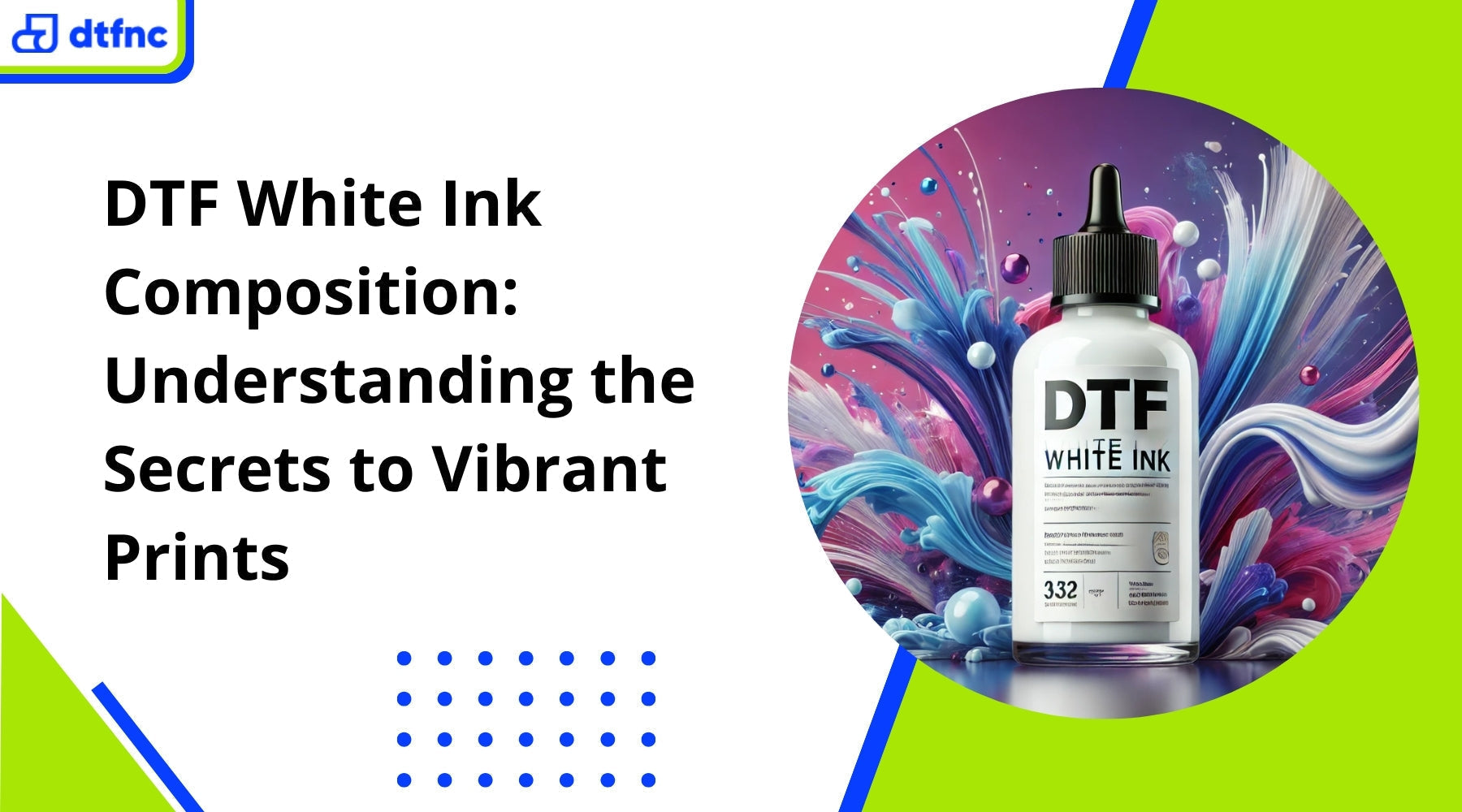Have you ever found yourself wondering if you could actually pull off a successful DTF transfer with a regular printer in or you're just about to give your printer an emotional breakdown?
Well, it’s certainly not just one brave soul with that idea. DTF print designs have been taking over everything, and the moment you see one on a T-shirt or a tote bag, it’s easy to want one for yourself. However, before diving in, it’s important to understand the very real differences between DTF and regular ink, because your project could either turn into a masterpiece or a colourful disaster.
In this blog, we are going to find out if ordinary ink can survive within the walls of DTF wild and why high-quality DTF ink is a VIP pass that your designs indeed deserve and what really happens when you try to cut corners.
What is DTF Transfer?
DTF transfer (Direct to Film) is a contemporary printing process whereby designs are printed onto a special transfer film using DTF printer inks and heat transfer onto fabrics. DTF printing produces more durable, vibrant, and flexible prints than those made using traditional inkjet heat transfer paper.
High-quality inks and film ensure that your designs never crack, peel, or look like they have gone through a washing machine battle. DTF transfer allows you to print anything from a plain T-shirt to a tote bag with professional results without needing the most expensive equipment in the world; just good materials and a bit of patience!
Can You Use Regular Printer Ink for DTF Transfers?

The kind of ink that you utilize is very crucial in DTF transfer printing, since this affects how well they perform. While it may be pretty tempting to use regular printer ink for a DTF transfer, it is most definitely not recommended.
These inks are designed explicitly for some unique requirements of DTF prints that need to keep a good balance among the dimensions of data, chemical compounds, and thickeners to ensure that the printing is durable, colourful, and long-lasting.
Reaching true flexibility, brightness, and it does not fade or peel after washing requires those DTF inks. Regular printer ink simply does not have such properties to stick well enough to the transfer film; hence, the resulting prints are of such poor quality that they may not even survive for the time within which they would normally be expected to last.
Using high quality DTF ink is key to achieving optimal results in this transfer printing process. This is the best ink for DTF transfer printing that is specifically designed to endure the temperature and pressure combinations involved in the transfer process, so that your designs do not lose out on their vibrancy and integrity
Differences Between DTF Ink and Regular Printer Ink
While it might seem tempting to try DTF transfer with regular printer ink, there are several key reasons why regular ink just doesn’t cut it for high-quality prints. Let’s break down the differences between DTF and regular ink:
1. DTF Ink vs Conventional Printer Ink:
-
This ink is built for a DTF transfer, meaning it is expected to interact well with transfer films and sustain temperature and pressure during the transfer.
-
Regular printer ink is designed for conventional paper and does not have the correct chemical properties to bond with the transfer films or withstand the rigours of heat press.
2. Ink Chemistry:
-
DTF inks use a specific chemistry that guarantees that after pressing, the design has maximum vibrance, flexibility, and durability concerning the fabric.
-
Regular printer inks do not have the right set of chemicals to retain their print integrity; thus, they would fade, peel, or crack after several washes.
3. Ink Pigmenting for DTF Printing:
-
Pigment ink is the more DTF-like of the two types of inks, which is rather closer than dye inks to DTF because of durability and water resistance.
-
But regular ink is not considered to work well enough in DTF printing. The proper bonding agents are still lacking in this one, which makes DTF ink suitable for long-lasting prints.
4. Compatibility of DTF Ink with Regular Printers:
-
DTF ink compatibility with standard printers is poor. Conventional printers have not been designed to deal with DTF ink and transfer film; hence, poor print quality and very low durability may result.
-
Setting up a regular DTF printer involves modifying the printer to handle the special inks and other processes regarding the transfer process.
5. Best Ink for DTF Transfer Printing:
The best ink for DTF transfer printing complies with all requirements for a heated press transfer to ensure its vibrant and durable prints.
Buying a specialized ink made for DTF means you can guarantee a really good-quality result, making the extra effort well worth it in comparison to regular printer ink.
What Happens if You Use Regular Ink for DTF Transfers?

1. Poor Adhesion to Transfer Film
Using DTF transfer with regular printer ink results in poor adhesion to the transfer film. Regular ink lacks the chemical properties required for a strong bond, leading to an incomplete or failed transfer.
2. Faded and Low-Quality Prints
Regular ink does not provide the high-quality DTF ink performance needed for vibrant and long-lasting prints. This leads to colors that are dull and may fade or look blurry after washing.
3. Incompatibility with Inkjet Heat Transfer Paper
Inkjet heat transfer paper is designed to work best with DTF ink for Epson or other DTF printer inks. Regular ink doesn’t bond well with the paper, resulting in poor transfer quality.
4. Reduced Durability
Regular ink cannot handle the heat press process, causing prints to fade, crack, or peel over time. DTF ink is specifically designed to endure these conditions, ensuring durable prints.
5. Overall Poor Transfer Results
Without the proper DTF printer inks, your DTF how to use process will yield low-quality transfers. Using specialized DTF inks ensures that your designs are vibrant, flexible, and long-lasting.
Also Read: How to Apply DTF Transfers with Iron: A Beginner’s Guide
How to Convert an Inkjet Printer for DTF Printing?
Converting a regular inkjet printer for DTF printing requires careful preparation and attention to detail. Here’s a straightforward process you can follow:
1. Select a Suitable Printer
Begin by selecting an inkjet printer that is compatible with DTF technology. Some Epson models are commonly used because they are easier to modify and can work efficiently with DTF printer inks.
2. Clean and Prepare the Printer
Remove any existing standard ink from the printer. Using DTF transfer with regular printer ink is not recommended, so the printer must be thoroughly cleaned to avoid contamination and ensure smooth DTF printing results.
3. Load High Quality DTF Ink
Install high-quality DTF ink into the printer. These inks are specifically designed for DTF applications, providing the necessary adhesion, vibrancy, and durability required for effective transfer to the fabric.
4. Install DTF Printing Software
Install a RIP software that supports DTF printing. This software controls the color profiles and manages the white ink layer, which is crucial for creating accurate and vivid DTF prints.
5. Adjust Printer Settings and Perform Test Prints
After setting up the printer with DTF printer inks, adjust the printer settings for optimal DTF output. Conduct test prints to ensure colour accuracy, ink flow, and proper adhesion to the transfer film.
Conclusion
Choosing to attempt a DTF transfer with regular printer ink might sound easy, but it won’t deliver the vibrant, lasting results you’re aiming for. True DTF printing success needs high quality DTF ink and the right process.
At DTFNC, we saw opportunities where others saw challenges and built a brand that redefines quality, precision, and customer satisfaction. Trust our passion and expertise to bring your prints to life.
Visit us today, where every print is a masterpiece in the making!
FAQs
1. Can you use regular printer ink for heat transfer?
No, regular printer ink is not designed for heat transfer processes. DTF transfer requires specialized ink that adheres properly to transfer film and withstands the heat and pressure.
2. Can you turn a regular printer into a DTF printer?
Yes, it’s possible to convert a regular printer for DTF, but it requires specialized modifications and hardware to handle DTF printer inks and transfer film effectively for high-quality results.
3. Can I print DTF with an inkjet printer?
You can print DTF transfer designs using an inkjet printer, but you’ll need to use DTF printer inks and ensure the printer is compatible with transfer film for proper adhesion and durability.
4. What ink can be used for DTF printing?
For optimal results, DTF printing requires high quality DTF ink specifically formulated to work with transfer film. Regular printer ink or pigment ink isn’t ideal for creating lasting, vibrant DTF prints.
Also Read More Related Blogs:

DTF White Ink Composition: Understanding the Secrets to Vibrant Prints









11 comments
📅 + 1.76842 BTC.NEXT - https://yandex.com/poll/enter/47uYv1jDg9Q2bCy1CSWpTp?hs=5b3a4eeaa2630cffcf5be9617352ef1c& 📅
mcvqc7
📆 + 1.306438 BTC.GET - https://yandex.com/poll/enter/Ha5VCjrXBk5FX2G3VMwSuc?hs=5b3a4eeaa2630cffcf5be9617352ef1c& 📆
3wq6lf
💌 Ticket: TRANSACTION 1.88237 BTC. Continue >> https://yandex.com/poll/enter/VEd5av2daj3Zn1ERBFLKSq?hs=5b3a4eeaa2630cffcf5be9617352ef1c& 💌
eg7ywp
📆 + 1.827448 BTC.NEXT - https://yandex.com/poll/enter/8UEdi2ihKWz3RazaLQttu1?hs=5b3a4eeaa2630cffcf5be9617352ef1c& 📆
mpd5t7
📩 Ticket; Process 1,334051 BTC. Get >> https://yandex.com/poll/enter/Ha5VCjrXBk5FX2G3VMwSuc?hs=5b3a4eeaa2630cffcf5be9617352ef1c& 📩
gxi1v3